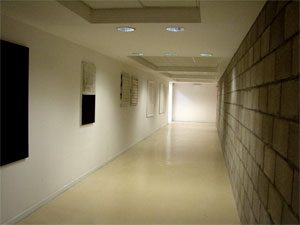The use of readymade in general, and shutters in particular, appeared in the work of various Israeli artists in the past decades, among them two polar examples such as Arie Aroch and Michael Gross. Tsibi Geva’s shutter works, however, created collectively as a differentiated body of work in 1993, are a type of hybrid between the found and the made-to-order. In terms of their materiality and nature, the shutters used in Geva’s work may indeed be identical to shutters available on the market, and in this sense, at first sight they resemble quintessential ready-mades; they were not, however, found in backyards or junkyards, nor were they taken from existing apartments, but rather ordered by the artist especially, according to specific size, material, and form, for the creation of this body of work. New shutters made of aluminum and plastic, devoid of baggage, human imprints, or nostalgia; a readymade, which ostensibly carries nothing but its being potentially a functional object in the world. In this respect, Geva’s plastic shutters undermine the notion of readymade, forming a conceptual antithesis, an expansion of the boundaries of its feasibility.
In his various painting series, such as the keffiyeh, terrazzo, or window, Geva’s point of departure included, at least allegedly, a certain descriptive element with regard to a given object in the world. The surface of the painting was constructed layer upon layer, by means of reproduction, distortion, and shifting, in a manner which echoed the chosen object, while at the same time, deviating from and adding to it. In contrast, the shutter series is based on an existing object which becomes a surface onto which action is applied. A concealed object which ostensibly disappears under the painterly surface, yet still outlines its existence. The act of painting occurring on the shutters is essentially monochromatic, oscillating between black and white; nevertheless, it bears signs and residues of coloration, which may have previously been vital and touched on shades of green, pink, or red, for example; and the coloration itself is excessive with regard to the object-stained, soiled, saturated.
The interrelations between the existent and the work of art in Geva’s work acquire different aspects in each of the series. Whereas in the painting series an illusion is created between the flatness of the given object and the painterly surface, on the one hand, and the sense of depth of the painterly illusion, on the other, the works in the shutter series are based on the superficiality of the painterly act, on the one hand, and the structuralism of the real object to which it is applied, on the other. Either way, in all of Geva’s works the visible is not the existent, and the existent is not always visible.
In the essay “Homeland (The Hole in the Painting, or the Painting that is Nothing but a Hole)” in the catalogue of Geva’s exhibition “Mound of Things” (Tel Aviv Museum of Art, 2008) I elaborated on Geva’s ongoing interest in painting and treating various, formal and conceptual elements of obstruction. Similarly, in the works in question, the shutters are always closed. Moreover, as if in order to enhance the sense of obstruction, of suffocation, perhaps even of helplessness vis-à-vis these shutters, Geva uses not only the existing element of the closed shutter, but further seals it, all its slits and cracks, with layers of paint, matter, and action. Still and all, in the context of this particular series, it appears as though the element of obstruction cannot be regarded as a mere leitmotif, recurring in Geva’s work throughout the years; one cannot avoid the circumstantial, biographical context; the fact that the series was created directly after his father’s death.
The title of the series, “Blinds,” embeds the double meaning of the shutter being an object in the world and of the obstruction of vision, or even blindness, as a condition resulting from it. The closed shutter blocks the ability to gaze through the window, whether at the landscape, at reality, or at art. Being shut and sealed, the shutter generates a gaze reflected back at itself, a gaze which crashes and collapses into the void forming within it. Thus, in this series Geva clearly does not address questions of vision and gaze, nor the depiction of the shutter, not even its coloring, but rather its transformation into an object in his world; a thing which is a present, painful, existential fact; corporeal and yet intangible.
The brick wall erected opposite the shutter works echoes the missing structure recently presented by Geva in the exhibition “Mound of Things.” As in other series where he revisits specific motifs at regular intervals over the years, this manifestation of construction is likewise a continuation of the process of research and exploration of the presence and significance of the block structure in the totality of his work. In this instance too, it is a wall made of standard, industrial concrete blocks constructed especially for the exhibition; a wall which is yet another manifestation of the element of formal circumscription existing in many of the paintings, of the grid’s structure and the sense of flatness and obstruction arising from some of them, and of the sequence of site-specific projects which he created over the years; a long and intricate series of manifestations ostensibly dealing with obstruction, while concealing a hollow core.
In the narrow exhibition space situated beneath ground level, the bare wall confronts the sealed shutters, leaving the viewer in-between, without available escape. In so doing, the notion of the home, recurring in Geva’s work throughout the years-in both his paintings and installations, via an ongoing presentation of a lexicon including terrazzo, shutter, window, lattice, wall-ultimately remains a refined place of yearning; an unrealized dream of a given, cohesive identity.
Hadas Maor, Exhibition Curator
Less Reading...
